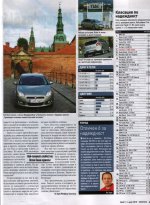(last part)
to the moderator - please, can you consolidate with main article and delete this post? I cannot edit the main one anymore.
Little wearing out, but negligence in some details
Good work, FIAT: if it weren’t the troubles, caused by the rodent’s teeth, this Italian would have passed the long test so effortlessly, as if it was a Japanese car from the beginning of the 90-ies. Have things in Torino changed so much? Yes, to some extent, but not fully, as evident from the chassis conservation. When DEKRA’s representative Gunter Schile checks with endoscope the chassis hollow parts, he notices drops of water and even rubbish around the rubber caps of the drainage holes. The caps seem placed after the anti-corrosion layer, so they don’t sit perfectly. Besides, the protecting wax in the hollow spaces is not distributed evenly. Some of the thermal protection shields above the exhaust are broken; one of them is even missing. The same is true with the ventilation holes at the back. One of the four rubber membranes is not correctly mounted. Improvement is also possible with the tight-moving wire of the gears, as well as with the badly firming muffs of the semi-axes. Special praise for the engine – it didn’t show any wearing out and performs even better than what’s stated by FIAT. The same is true for the gearbox and the clutch. Electrical connections and cables are also fine. Seats are also in great condition. Well done, FIAT.
Excellent (6) for reliability
Who would think of that – FIAT Bravo goes 100,000 kilometers without any technical problem. This is an achievement, which was not up to any VW in the history of our tests. Undoubtedly, the well-known negligence of FIAT was also noticed here and there. Official garages might have been much better. Build quality might have been even higher. The specifics of driving a Bravo are excusable – eventually you’ll get used to control the navigation from the ceiling. In the end, Bravo deserved its score (6) and our sincere applauds.
Repairs
At 62,223 km – new front brake discs and pads (300 EUR)
At 92,337 km – new rear brake pads (100 EUR)
At 96,750 km – replacement of fuse of turbo compressor, eaten by a rodent (40 EUR)
At 96,590 km – the Bravo goes in service mode for a second time. Replaced parts: exhaust gas recirculation valve, DPF, exhaust collector and collector’s gasket. In fact, only the last two really needed replacement.
At 103,000 km – replacement of died rear bulb (8 EUR)
Expenses for two years
Insurance: 1650 EUR
Taxes: 330 EUR
State insurance (not sure how you call that, it’s something like “civil responsibility” here and makes your insurance company pay for the damages you did to another car): 160 EUR
Fuel expenses (for 100,000 km): 7084 liters, 6730 EUR
Oil topping: 1,5 liters
Service costs (including oil change):
15,000 km – 230 EUR
30,000 km – 230 EUR
45,000 km – 230 EUR
60,000 km – 250 EUR
75,000 km – 565 EUR
90,000 km – 230 EUR
Tire costs (including montage):
2 sets of summer tires Bridgestone Turanza ER300 205/55 R16 V
1 set of winter tires Pirelli 190 Snowcontrol 195/65 R15 T
Price and loss of value:
Price of test car, April 2008: 18,745 EUR
Current price of new car (for 2.0 MJet 165): 20,745 EUR
Estimated price February 2010: 9,950 EUR
Loss of value of test car: 8,795 EUR
Total expenses for two years:
For 100,770 km – 11,755 EUR
Cost per km – 0,12 EUR
Cost per km, including loss of value – 0,20 EUR
Readers’ letters
Great design, too wide back column. I would recommend parktronic to everyone, because the rear column is too wide. Bravo is a wonderful car, not perfect unfortunately. (Bravo 1.6 MJT)
Engines: market share
1,4 120 bhp: 51%
1,4 90 bhp: 23%
1,4 150 bhp: 10%
1,6 MJT 120 bhp: 8%
1.9/2.0 MJT 150/165 bhp: 5%
1,6 MJT 105: 3%
Colors: market share
Black: 33%
Red: 21%
Grey: 20%
White: 15%
Blue: 9%
Silver: 2%


